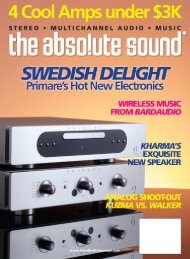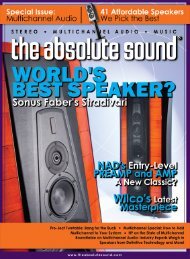Contents
Contents
Contents
You also want an ePaper? Increase the reach of your titles
YUMPU automatically turns print PDFs into web optimized ePapers that Google loves.
Letters<br />
More on MAGICO<br />
I’ve read Jonathan’s Magico review a couple of times over. One item of<br />
curiosity for prospective purchasers like myself with small rooms: Can<br />
we get far enough away from the speakers for the drivers to integrate<br />
properly What was/is JV’s listening distance or range of listening distances<br />
of choice<br />
Kevin Kwann<br />
JV replies: In a room that is roughly 17.5' x 16' x 10' I sat anywhere from<br />
8' to 10.5' away from the Minis, which were themselves about 3' 5" from<br />
the backwalls (measuring from the rear of the Minis’ enclosures) and<br />
about 3' 4" away from sidewalls (measuring from the outside middle of<br />
the Minis’ enclosures). The Minis’ drivers blended perfectly at any and all<br />
of my listening positions. (I preferred about 8.5' for the greater sense of<br />
immersiveness.)<br />
Focus on Music<br />
Thanks so much for Derk Richardson’s article on free-jazz guitarists in<br />
last month’s issue. I now have a road map for several months of musical<br />
purchases.<br />
The inclusion of Sonny Sharrock in the article brought a nostalgic smile to<br />
my face. On a late night in 1988 I was lying in the trunk of a Jetta installing a<br />
car stereo when the local community radio station (KBOO) put on Sharrock’s<br />
Guitar and let it play through. At the time I was twenty-something, playing<br />
guitar in a couple of fairly experimental rock bands, and heavily influenced<br />
by guitarists whom I naively thought represented the exploratory edge of the<br />
rock-guitar hinterlands (Hendrix, Garcia, Zappa, etc.). Sharrock opened my<br />
eyes to what might best be described as an alternative universe of possibility<br />
using the guitar as a musical tool—a change in perception akin to the switch<br />
from black-and-white to color in the Wizard of Oz. I spent the next 18 months<br />
searching record store bins looking for Guitar. (No instant gratification of<br />
search and buy on the Internet back then!) I highly recommend this record,<br />
particularly to students of the guitar, as a potentially life-altering bit of art and<br />
tour de force of unique virtuosity.<br />
Bravo for your focus on music. The search for the absolute sound is in part<br />
about the playback equipment. It should also be open to the opportunity<br />
for epiphanies like the one I had in a car trunk all those years ago.<br />
Spot On<br />
Steve Claussen<br />
Aquick note to say that Robert Harley’s review of the Mark Levinson<br />
Nº 326s [Issue 162] was spot on. As a jaded audiophile who reads the<br />
reviews with some reservation I must say that RH called it as I have<br />
experienced it. I purchased a 326s to replace the “awesome” Audio Research<br />
Reference 3 expecting the 326s to be flat (no depth) and boring among other<br />
things. I personally can’t think of one thing about the Ref. 3 that I prefer and I<br />
never thought I’d say that about a piece of solid-state gear. I don’t know what<br />
magic Mark Levinson put in this unit but it is very good. Rumor has it that those<br />
in the know prefer it to the No. 32. Anyway thanks again for a great “tip,” and<br />
keep up the good work!<br />
BTW, I’m using Wilson Sophia 2s and think they, too, are incredible.<br />
Tim Wilson<br />
OF MAGNETS &<br />
TURNTABLES<br />
In your last issue, HP states that the two new turntables from<br />
EAR and Blue Pearl use new technology. The newly implemented<br />
magnetic suspension, and more importantly magnetic drive,<br />
have been used in turntable design and manufacture before!<br />
I only know this as, several months ago, I purchased via eBay a<br />
“Magnafloat” TEAC turntable from the 70s. Right now I am having<br />
it mounted on a custom-designed plinth. It will have the ability to<br />
mount an arm of choice. Anyway, just a little-known fact for you.<br />
Robin Wyatt<br />
Robyatt Audio<br />
HP replies: I didn’t use that exact phrase, nor did I intend to.<br />
There was much more I could have said about the use of magnets<br />
in turntable design, which I didn’t (space and time limitations),<br />
although neither I nor anyone else I know of writing about the high<br />
end ever heard of that specific and long-since-discontinued TEAC<br />
turntable.<br />
“What is ‘new’ is the sudden<br />
mini-boomlet in the use of<br />
magnets in ’table design...”<br />
More seriously, Mr. Wyatt fails to mention just how magnets<br />
were used in the table: Was it in the bearings (as in the French<br />
Verdier and English Blue Pearl), or was it, and much more unlikely,<br />
as a magnetic drive, which was not a first in the case of the EAR<br />
turntable I reviewed. (A small one-man shop in Britain beat EAR to<br />
the punch. Clearaudio, whose table is now available at more than<br />
five times the cost of the EAR, was then being developed.) Frankly,<br />
given the state of magnet technology almost four decades ago, I<br />
would be surprised if the TEAC application was either extensive or<br />
practical. It certainly did not, as far as we know, breed imitators.<br />
What is “new” is the sudden mini-boomlet in the use of magnets<br />
in ’table design and that, a point I was trying to make clear, is<br />
potentially revolutionary.<br />
Upcoming in TAS<br />
• Feature & Roundtable on Class D Amplifiers<br />
• Chapter Précis integrated amp<br />
• Ascendo M loudspeaker<br />
• NAD 720BEE receiver<br />
• Stirling LS3/5a loudspeaker<br />
• Eben X3 loudspeaker<br />
October 2006 The Absolute Sound










